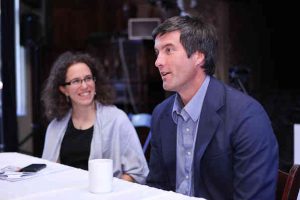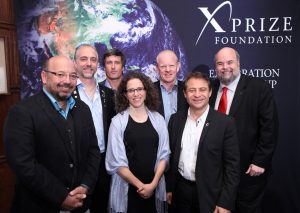An estimated 250 million children around the world cannot read, write, or demonstrate basic arithmetic skills. Many of these children are in developing countries without regular access to quality schools or teachers. While programs exist to build schools and train teachers, traditional models of education are not able to scale fast enough to meet demand. We simply cannot build enough schools or train enough teachers to meet the need. We are at a pivotal moment where an innovative approach is necessary to eliminate existing barriers to learning, enabling the seeds of innovation to be imparted to every child, regardless of geographic location or economic status.
XPRIZE Chairman and CEO, Dr. Peter H. Diamandis announced the $15M Global Learning XPRIZE today to help solve these challenges. The Global Learning XPRIZE is a five-year competition challenging teams to develop an open source solution that can be iterated upon, scaled and deployed around the world, bringing quality learning experiences to children no matter where they live. Enabling children in developing countries to teach themselves basic reading, writing and arithmetic.
At the same time, XPRIZE will launch an online crowdfunding campaign to mobilize a global street team of supporters to get involved with the Global Learning XPRIZE. Every dollar pledged will go towards optimizing the success of the prize, specifically focusing on supporting team recruitment globally and expanding field testing.
The Global Learning XPRIZE will launch with a six-month team registration period followed by 18 months of solution development. A panel of third-party expert judges will then evaluate and select the top five teams to proceed in the competition, and award each of them a $1M award. Solutions will be tested in the field with thousands of children in the developing world, over an 18-month period. The $10M top prize will ultimately be awarded to the team that develops a technology solution demonstrating the greatest levels of proficiency gains in reading, writing and arithmetic.
The learning solutions developed by this prize will enable a child to learn autonomously. And, those created by the finalists will be open-sourced for all to access, iterate and share. This technology could be deployed around the world, bringing learning experiences to children otherwise thought unreachable, who do not have access to quality education, and supplementing the learning experiences of children who do.
The impact will be exponential. Children with basic literacy skills have the potential to lift themselves out of poverty. And that’s not all. By enabling a child to learn how to learn, that child has opportunity – to live a healthy and productive life, to provide for their family and their community, as well as to contribute toward a peaceful, prosperous and abundant world.
XPRIZE believes that innovation can come from anywhere and that many of the greatest minds remain untapped.
What might the future look like with hundreds of millions of additional young minds unleashed to tackle the world’s Grand Challenges?
The Global Learning XPRIZE is funded by a group of donors, including the Dick & Betsy DeVos Foundation, the Anthony Robbins Foundation, the Econet Foundation, the Merkin Family Foundation, Scott Hassan, John Raymonds and Suzanne West.
For more information, visit http://learning.xprize.org.
COMMENTARY
I am very excited about this new effort, as I am a big believer that we should live in a world where the next Einstein could come from anywhere, but I have a few of concerns:
- It seems to be focused on the use of technology
- Five years is a long time (will they get a five-year-old solution?)
- It doesn’t engage the target users in co-creation throughout the whole process (it’s outside in)
- It seems to ignore the infrastructure in place in areas of the greatest need (where students don’t even have desks)
- The most capable solutions may be too expensive to implement in the target areas
- The goal should be to build an autonomous learning system that can be used for reading, writing, and arithmetic, but also extended to do much more
- Teaching students skills autonomously is fine as long as there is social practice as part of the curriculum
- An over-reliance on autonomous teaching will lead to less innovation not more
- We are already seeing negative effects in first-world society from too much reliance on technology
- If we want more innovation, we need to be teaching our kids ICE skills not just STEM, ICE being Invention, Collaboration, and Entrepreneurship – these are all social skills that don’t need technology (but can use it)
For more on my views on improving education (which doesn’t require education reform or new technology), please see my article Stop Praying for Education Reform.
For those of you who are going to enter a team, I look forward to seeing what you come up with and I hope that you’ll keep some of the above in mind!

![]() Sign up here to get Human-Centered Change & Innovation Weekly delivered to your inbox every week.
Sign up here to get Human-Centered Change & Innovation Weekly delivered to your inbox every week.


 I had the opportunity to hear Mark Synnott speak of how despite the enormous risk he undertakes in his climbing explorations, that the thing that scares him most is the possibility of slipping on easy ground. When he is attempting a difficult portion of a climb, he is always thinking about what his exposure to risk is, but on easy portion it is easy to forget to take proper precautions. Yet, when it comes to his kids Mark thinks he is probably one of the world’s most over-protective parents, but at the same time he wants to inspire his kids to be curious about the world.
I had the opportunity to hear Mark Synnott speak of how despite the enormous risk he undertakes in his climbing explorations, that the thing that scares him most is the possibility of slipping on easy ground. When he is attempting a difficult portion of a climb, he is always thinking about what his exposure to risk is, but on easy portion it is easy to forget to take proper precautions. Yet, when it comes to his kids Mark thinks he is probably one of the world’s most over-protective parents, but at the same time he wants to inspire his kids to be curious about the world. Peter Diamandis talked about how we need to ask where a breakthrough should be possible and focus on structuring an innovation challenge to help harness people’s curiosity to push past current obstacles in thinking or execution. Peter has learned first-hand that small teams are amazingly powerful, and talked about how big organizations focus on reducing risk by throwing lots of money and resources at a challenge. On the flip side though, when you put a box around a challenge with a small budget and a small team, then that small team of people will know the traditional approach will fail – and try a different approach.
Peter Diamandis talked about how we need to ask where a breakthrough should be possible and focus on structuring an innovation challenge to help harness people’s curiosity to push past current obstacles in thinking or execution. Peter has learned first-hand that small teams are amazingly powerful, and talked about how big organizations focus on reducing risk by throwing lots of money and resources at a challenge. On the flip side though, when you put a box around a challenge with a small budget and a small team, then that small team of people will know the traditional approach will fail – and try a different approach. In speaking with David Gallo about exploration of the seas, he spoke about how when we oversell a danger like climate change in the media, it is damaging – there is no plastic island the size of Texas in the middle of the ocean. But there is a chemistry change in the ocean, a soup, a film leads to us eating our own garbage as plastic, flame retardants, and other runoff embed themselves in the tissue of the fish we eat. We have changed the temperature and the chemistry of the oceans, and anyone who has an aquarium knows that’s a bad idea.
In speaking with David Gallo about exploration of the seas, he spoke about how when we oversell a danger like climate change in the media, it is damaging – there is no plastic island the size of Texas in the middle of the ocean. But there is a chemistry change in the ocean, a soup, a film leads to us eating our own garbage as plastic, flame retardants, and other runoff embed themselves in the tissue of the fish we eat. We have changed the temperature and the chemistry of the oceans, and anyone who has an aquarium knows that’s a bad idea.